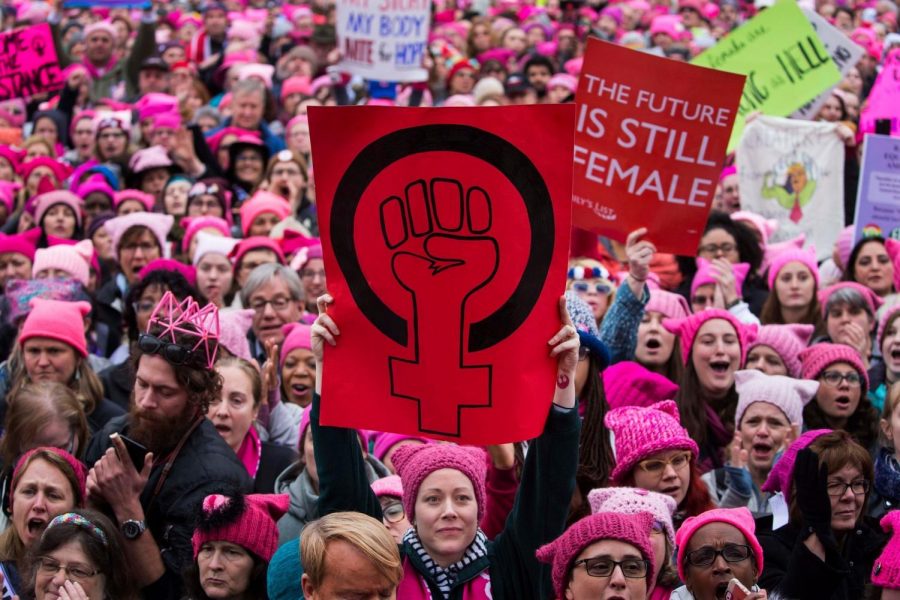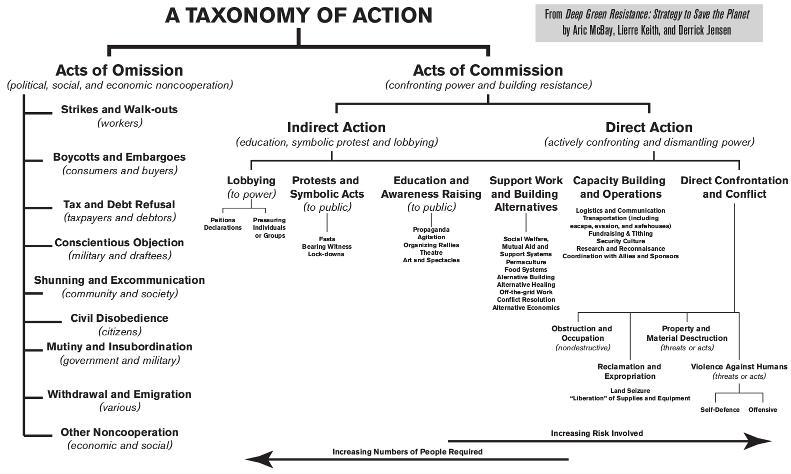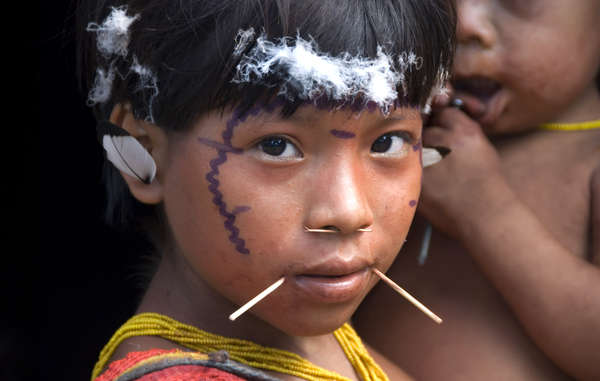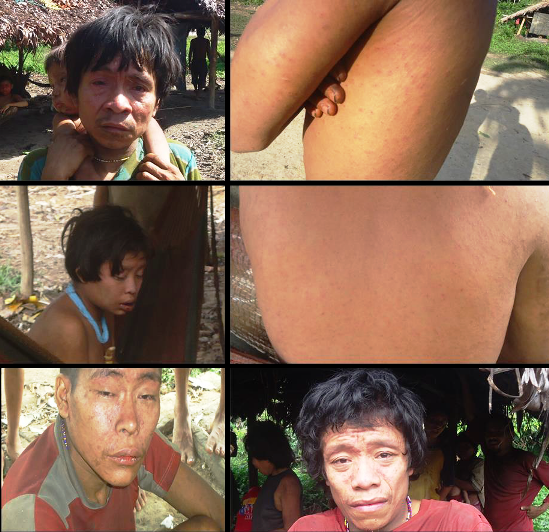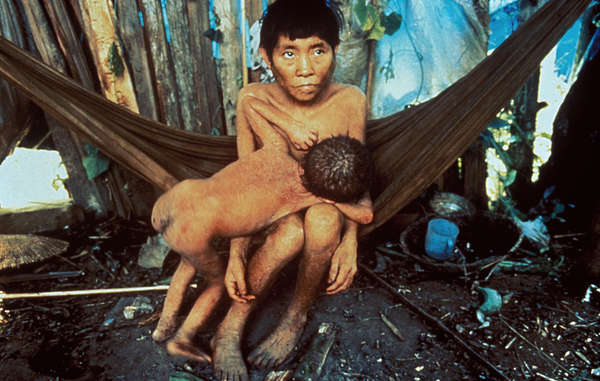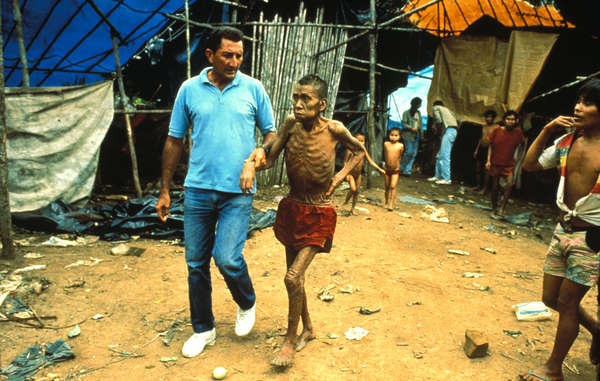As we’ve made clear, acts of omission are not going to bring down civilization. Let’s talk about action with more potential. We can split all acts of commission into six branches:
The illustration “Taxonomy of Action” groups them by directness. The most indirect tactics are on the left, and become progressively more direct when moving from left to right. More direct tactics involve more personal risk. (The main collective risk is failing to save the planet.) Direct acts require fewer people.
Lobbying seems attractive because if you have enough resources (i.e., money), you can get government to do things for you, magnifying your actions. Success is possible when many people push for minor change, and unlikely when few people push for major change. But lobbying is too indirect—it requires us to try to convince someone to convince other people to make a decision or pass a law, which will then hopefully be enacted by other people, and enforced by yet a further group.
Lobbying via persuasion is a dead end, not just in terms of taking down civilization, but in virtually every radical endeavor. It assumes that those in power are essentially moral and can be convinced to change their behavior. But let’s be blunt: if they wanted to do the right thing, we wouldn’t be where we are now. Or to put it another way, their moral sense (if present) is so profoundly distorted they are almost all unreachable by persuasion.
And what if they could be persuaded? Capitalists employ vast armies of professional lobbyists to manipulate government. Our ability to lobby those in power (which includes heads of governments and corporations) is vastly outmatched by their ability to lobby each other. Convincing those in power to change would require huge numbers of people. If we had those people, those in power wouldn’t be convinced—they would be replaced. Convincing them to mend their ways would be irrelevant, because we could undertake much more effective action.
Lobbying is simply not a priority in taking down civilization. This is not to diminish or insult lobbying victories like the Clean Water Act and the Wildlife Act, which have bought us valuable time. It is merely to point out that lobbying will not work to topple a system as vast as civilization.
When effective, demonstrations are part of a broader movement and go beyond the symbolic. There have been effective protests, such as the civil rights actions in Birmingham, but they were not symbolic; they were physical obstructions of business and politics. This disruption is usually illegal. Still, symbolic protests can get attention. Protests are most effective at “getting a message out” when they focus on one issue. Modern media coverage is so superficial and sensational that nuances get lost. But a critique of civilization can’t be expressed in sound bytes, so protests can’t publicize it. And civilization is so large and so ubiquitous that there is no one place to protest it. Some resistance movements have employed protests, to show strength and attract recruits, but the majority of people will never be on our side; our strategy needs to be based on effectiveness, not just numbers.
For public education to work, several conditions must be met. The resistance education and propaganda must be able to outcompete the mass media. The general public must be able and willing to unravel the prevailing falsehoods, even if doing that contravenes their own social, psychological, and economic self-interest. They must have accessible ways to change their actions, and they must choose morally preferable actions over convenient ones. Unfortunately, none of these conditions are in place right now.
Another drawback of education is its built-in delay; it may take years before a given person translates new information into action. But as we know, the planet is being murdered, and the window for effective action is small. For deep green resisters, skills training and agitation may be more effective than public education.
Education won’t directly take down civilization, but it may help to radicalize and recruit people by providing a critical interpretation of their experiences. And as civilization continues to collapse, education may encourage people to question the underlying reasons for a declining economy, food crises, and so on.
These support structures directly enable resistance. The Quakers’ Society of Friends developed a sturdy ethic of support for the families of Quakers who were arrested under draconian conditions of religious persecution (see Chapter 4: “Loyalty, Material Support, & Leadership”). People can take riskier (and more effective) action if they know that they and their families will be supported.
Building alternatives won’t directly bring down civilization, but as industrial civilization unravels, alternatives have two special roles. First, they can bolster resistance in times of crisis; resisters are more able to fight if they aren’t preoccupied with getting food, water, and shelter. Second, alternative communities can act as an escape hatch for regular people, so that their day-to-day work and efforts go to autonomous societies rather than authoritarian ones.
To serve either role, people building alternatives must be part of a culture of resistance—or better yet, part of a resistance movement. If the “alternative” people are aligned with civilization, their actions will prolong the destructiveness of the dominant culture. Let’s not forget that Hitler’s V2 rockets were powered by biofuel fermented from potatoes. The US military has built windmills at Guantanamo Bay, and is conducting research on hybrid and fuel-cell vehicles. Renewable energy is a necessity for a sustainable and equitable society, but not a guarantee of one. Militants and builders of alternatives are actually natural allies. As I wrote in What We Leave Behind, “If this monstrosity is not stopped, the carefully tended permaculture gardens and groves of lifeboat ecovillages will be nothing more than after-dinner snacks for civilization.” Organized militants can help such communities from being consumed.
In addition, even the most carefully designed ecovillage will not be sustainable if neighboring communities are not sustainable. As neighbors deplete their landbases, they have to look further afield for more resources, and a nearby ecovillage will surely be at the top of their list of targets for expansion. An ecovillage either has to ensure that its neighbors are sustainable or be able to repel their future efforts at expansion.
In many cultures, what might be considered an “alternative” by some people today is simply a traditional way of life—perhaps the traditional way of life. Peoples struggling with displacement from their lands and dealing with attempts at assimilation and genocide may be mostly concerned with their own survival and the survival of their way of life. And for many indigenous groups, expressing their traditional lifestyle and culture may be in itself a direct confrontation with power. This is a very different situation from people whose lives and lifestyles are not under immediate threat.
Of course, even people primarily concerned with the perpetuation of their traditional cultures and lifestyles are living with the fact that civilization has to come down for any of us to survive. People born into civilization, and those who have benefitted from its privilege, have a much greater responsibility to bring it down. Despite this, indigenous peoples are mostly fighting much harder against civilization than those born inside of it.
Every successful historical resistance movement has rested upon a subsistence base of some kind. Establishing that base is a necessary step, but that alone is not sufficient to stop the world from being destroyed.
Capacity Building and Logistics
Capacity building and logistics are the backbone of any successful resistance movement. Although direct confrontation and conflict may get the glory, no sustained campaign of direct action is possible without a healthy logistical and operational core. That includes the following:
Resistance movements of all kinds must be able to screen recruits or volunteers to assess their suitability and to exclude infiltrators. Members of the group must share certain essential viewpoints and values (either assured through screening or teaching) in order to maintain the group’s cohesion and focus.
Resisters need to be able to communicate securely and rapidly with one another to share information and coordinate plans. They may also need to communicate with a wider audience, for propaganda or agitation. Many resistance groups have been defeated because of inadequate communications or poor communications security.
Resistance requires funding, whether for offices and equipment, legal costs and bail, or underground activities. In aboveground resistance, procurement is mostly a subset of fund raising, since people can buy the items or materials they need. In underground resistance, procurement may mean getting specialized equipment without gathering attention or simply getting items the resistance otherwise would be unable to get.
Of course, fund raising isn’t just a way to get materials, but also a way to support mutual aid and social welfare activities, support arrestees and casualties or their families, and allow core actionists to focus on resistance efforts rather than on “making a living.”
People and equipment need access to transportation in order to reach other resisters and facilitate distribution of materials. Conventional means of transportation may be impaired by collapse, poverty, or social or political repression, but there are other ways. The Underground Railroad was a solid resistance transportation network. The Montgomery bus boycott was enabled by backup transportation systems (especially walking and carpooling) coordinated by civil rights organizers who scheduled carpools and even replaced worn-out shoes.
Security is necessary for any group big enough to make a splash and become a target for state intelligence gathering and repression. Infiltration is definitely a concern, but so is ubiquitous surveillance. This does not apply solely to people or groups considering illegal action. Nonviolent, law-abiding groups have been and are surveilled and disrupted by COINTELPRO-like entities. Many times it is the aboveground resisters who are more at risk as working aboveground means being identifiable.
Research and reconnaissance are equally important logistical tools. To be effective, any strategy requires critical information about potential targets. This is true whether a group is planning to boycott a corporation, blockade a factory, or take out a dam.
Imagine how foolish you’d feel if you organized a huge boycott against some military contractor, only to find that they’d recently converted to making school buses. Resistance researchers can help develop a strategy and identify potential targets and weaknesses, as well as tactics likely to be useful against them. Research is also needed to gain an understanding of the strategy and tactics of those in power.
There are certain essential services and care that keep a resistance movement running smoothly. These include services like the repair of equipment, clothing, and so on. Health care skills and equipment can be extremely valuable, and resistance groups should have at least basic health care capabilities, including first aid and rudimentary emergency medicine, wound care, and preventative medicine.
Coordination with allies and sponsors is often a logistical concern. Many historical guerilla and insurgent groups have been “sponsored” by other established revolutionary regimes or by states hoping to foment revolution and undermine unfriendly foreign governments. For example, in 1965 Che Guevera left postrevolutionary Cuba to help organize and train Congolese guerillas, and Cuba itself had the backing of Soviet Russia. Both Russia and the United States spent much of the Cold War “sponsoring” various resistance groups by training and arming them, partly as a method of trying to put “friendly” governments in power, and partly as a means of waging proxy wars against each other.
Resistance groups can also have sponsors and allies who are genuinely interested in supporting them, rather than attempting to manipulate them. Resistance in WWII Europe is a good example. State-sponsored armed partisan groups and other partisan and underground groups supported resistance fighters such as those in the Warsaw Ghetto.
Direct Conflict and Confrontation
Ultimately, success requires direct confrontation and conflict with power; you can’t win on the defensive. But direct confrontation doesn’t always mean overt confrontation. Disrupting and dismantling systems of power doesn’t require advertising who you are, when and where you are planning to act, or what means you will use.
Back in the heyday of the summit-hopping “antiglobalization” movement, I enjoyed seeing the Black Bloc in action. But I was discomfited when I saw them smash the windows of a Gap storefront, a Starbucks, or even a military recruiting office during a protest. I was not opposed to seeing those windows smashed, just surprised that those in the Black Bloc had deliberately waited until the one day their targets were surrounded by thousands of heavily armed riot police, with countless additional cameras recording their every move and dozens of police buses idling on the corner waiting to take them to jail. It seemed to be the worst possible time and place to act if their objective was to smash windows and escape to smash another day.
Of course, their real aim wasn’t to smash windows—if you wanted to destroy corporate property there are much more effective ways of doing it—but to fight. If they wanted to smash windows, they could have gone out in the middle of the night a few days before the protest and smashed every corporate franchise on the block without anyone stopping them. They wanted to fight power, and they wanted people to see them doing it. But we need to fight to win, and that means fighting smart. Sometimes that means being more covert or oblique, especially if effective resistance is going to trigger a punitive response.
That said, actions can be both effective and draw attention. Anarchist theorist and Russian revolutionary Mikhail Bakunin argued that “we must spread our principles, not with words but with deeds, for this is the most popular, the most potent, and the most irresistible form of propaganda.”30 The intent of the deed is not to commit a symbolic act to get attention, but to carry out a genuinely meaningful action that will serve as an example to others.


